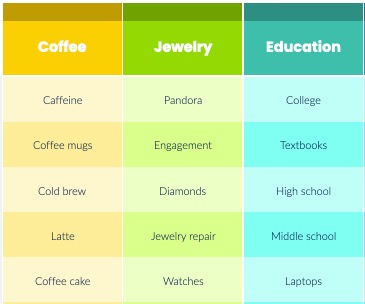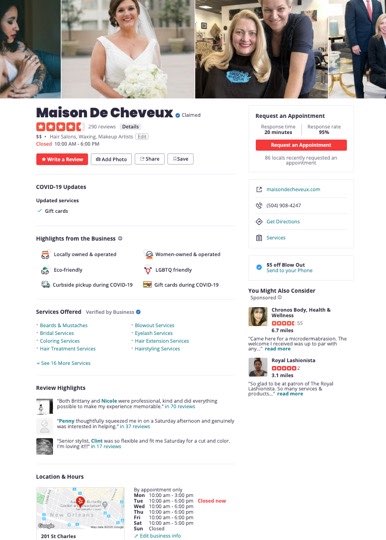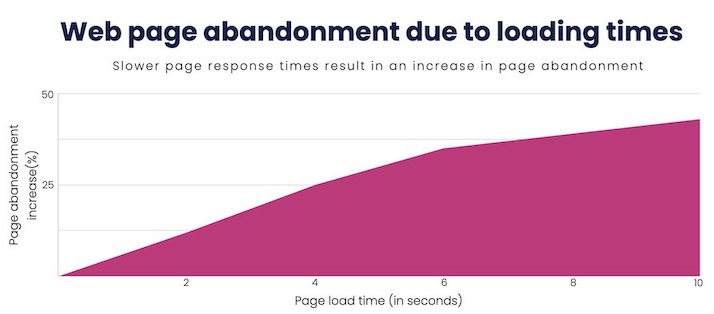Improve brand properties to supercharge brand reputation online
Did you know? The top result on Google has a 33% chance of getting clicked.
It’s no secret that your website needs to rank well on Google to survive. That’s why there are countless blogs, podcasts and news articles on the subject.
When you search “How to improve your Google ranking” millions of results pop up. Some are helpful. Some not. So how do you sift through the clutter?
In this post, we are going to share some important info about web properties that you can use to improve your ranking. We’ll share our top tips for improving your website’s search engine optimization (SEO), so you can watch your owned web properties rise in search results.
10 Tips to improve your Google ranking by optimizing owned web properties:
- The secret to rank for competitive keywords
- Use related keywords to beat the competition
- Maximize your local listings
- Use videos to promote your product or service
- Increase landing page speed
- Create high-quality content
- Include images and videos in your content
- Optimize your images
- Optimize your site for mobile devices
- Create optimized URLs
The secret to rank for competitive keywords
It’s hard to rank for competitive keywords. The competition is much more serious for competitive keywords like “pizza” or “furniture.” Most businesses don’t even bother trying to rank for competitive keywords and instead focus on more specific long-tail keywords like “mid-century modern furniture.”
Long-tail keywords should absolutely be a part of your SEO strategy. But you shouldn’t toss competitive keywords out of the picture. It’s difficult for a website without a high authority to rank for these competitive keywords because there are already established niche-specific sites that are publishing fresh content every day.
To compete with them requires a lot of effort, time, and usually money.
The first way to rank is to find niche-specific sites that provide sponsors to their site. This can drive some of their traffic to your site. But it’s not cheap, and some site owners can set hefty price tags depending on the site and its reach.
This trick is only applicable to those who want to focus on a big niche so that they can reach small niche sites to get traffic from a lot of small sites.
The second way is for all websites, and that is guest posting. This is the most effective way to quickly expand your reach and lends credibility to your brand. But keep in mind that guest posting is an overused tactic, so don’t rely entirely on it.
What is guest posting? Guest posting basically means you write an article for more powerful sites and in return they provide you with a link. These links increase the credibility of your site.
Use related keywords to beat the competition
Related keywords offer a way to extend your reach past your target keywords. There are plenty of keywords that are related to your target keyword that may also be worth working into your keyword strategy.
Related keywords help to associate your brand with its products so that search engines will rank your brand for its keyword. It can also serve as inspiration for future blog posts or link building campaigns. How to find related keywords? Ubersuggest is a popular tool for keyword research.
Maximize your local listings
Many companies that are still developing an SEO strategy will list their business on Google My Business and stop there. However, this is not enough to get your business to rank for most local keywords. There is so much competition on Google My Business and the platform doesn’t allow much flexibility.
But there are a lot of other sites for listings, and they can provide extra control over the information you share and how to optimize your listing.
For example, the below Yelp page includes all of the basic business information and highlights key features of the business, top services offered, highlighted reviews, and even a $5 coupon for customers.
Some other local listing sites are:
- Yelp
- Foursquare
- TripAdvisor
You can actually perform On-Page SEO on these sites and rank your title for specific keywords. Understand and research different keywords so that you can check which ones are making you a profit.
Use videos to promote your product or service
Nowadays, videos take up most of our attention on the Internet. People love videos for everything from entertainment to watching a product review.
So, if you want to sell a product and want to get more traffic, there are two ways to do that:
- Start making your own review videos and increase your following on sites like YouTube
- Market your product to influencers with sizable audiences in the hopes of getting a positive review
I personally like the 2nd one because this reduces a lot of effort and time on your part.
From this, you are getting video reviews from your target audience (and Google loves videos).
Focus on niche social media platforms
The ruling titans of social media are Facebook, Twitter, Instagram, and TikTok. So it is obviously very important to be on these platforms.
But there are some extremely valuable social media platforms that are dedicated to a specific niche, such as:
- Crunchbase: News site where you can share an article or post.
- Reddit: User-generated content and forums where you can do social marketing for your product.
- Idea Mensch: Q&A-based site where you can openly discuss your product to a relevant audience.
- Vimeo: Video sharing site where you can upload videos like YouTube and can expand your brand awareness.
Increase landing page speed
If you’re only going to add one of these points to your SEO strategy, page speed is your number one thing to do. If your site is not loading quickly, I’m sorry to tell you that you are losing lots of potential traffic. Google will not rank your site as well, and you will be doomed to the lower-ranking pages.
Negative interactions can hurt your ranking badly. A slow speed is one of those reactions. The graph below shows how speed can negatively affect your traffic.
To check the speed of your site, there’s a free tool by Google called Page Speed Insights. Pingdom is another great tool.
The faster your site loads, the more traffic you will get because your visitors will appreciate the quick loading. If your site loads too slowly, people will leave to find another site that loads fast.
Create high-quality content
One thing that’s remained constant through Google’s many updates is the need for quality content. Content is one of the most powerful ranking factors.
In order to improve your ranking, your content needs to be informative, interesting, and engaging. And once you upload it, you have to update it to keep it fresh.
When you have high-quality content on your site, visitors will spend more time on your website or blog. The more time they spend consuming your content, the higher Google will rank it.
The same goes for the number of pages that people bookmark. This is an indication that your content is worth saving and returning to, which means Google may raise your ranking.
Include images and videos in your content
Images and videos are another factor that Google considers when ranking your web pages. Videos can break up large blocks of text, making your blogs informative and interesting. This can increase the amount of time visitors spend on your blog and improve your ranking.
Tip: To keep your viewers engaged for several minutes, you can upload a video.
Optimize your images
Large images can affect the loading speed of your site. This can also affect your ranking. Large images are the number one slow page speed factor.
You should resize or compress images before uploading them to your website or article. Ideally, images should be below 100K in size, preferably well below.
You can also use keywords into your image to rank your images and get links from those images. Sometimes your images will rank in the image search results, which can also increase traffic to your site.
A good practice for uploading images is to:
- First, check the size and format
- Rename the image to include your keywords
Optimize your site for mobile devices
60% of searches are done from mobile devices.
This is a huge majority of your audience and we don’t want to lose them due to a poorly-optimized web page. Your site should always look good, no matter what type of device your audience is using to view it. This gives the visitor the best possible experience.
Google sees it as well and ranks according to this.
For example, if you as a visitor visit a site on your mobile phone and you get a bad experience, you will definitely not visit that site again.
Create optimized URLs
URLs should have your targeted keyword without any other unnecessary words or emotional impact words. You can create a great and catchy title but your URL must be straight to the point.
Final thoughts
SEO is growing and changing day by day and we have to stay up-to-date with the latest techniques coming. The better your site ranks, the more visitors you will receive.
Understanding the basic principles of SEO will also help you to take control of your search results, which is a valuable asset if you are trying to promote positive content or suppress negative content.
I hope you enjoyed my blog. Feel free to share it and leave a comment.
Improve Google Ranking FAQS
What are long-tail keywords?
Long-tail keywords are highly-specific phrases that use when searching for something online. They contain higher word counts than competitive keywords like pizza or furniture. An example of a long-tail keyword is mid-century modern furniture.
How do you rank for long-tail keywords?
One of the most effective ways to rank for long-tail keywords is to increase the credibility of your site by regularly publishing blog posts and guest posts on other sites. You can also find niche-specific sites that provide sponsors to drive some of their traffic to your site.
What are related keywords?
Related keywords are the other words that people may search for that aren’t an exact match of your target keyword. They help to associate your brand with its products so that search engines will rank your brand for its keyword.
How do I find related keywords?
Ubersuggest is a popular tool for keyword research.




